Structural, lattice vibrational, optical and microwave dielectric studies on Ca1-xSrxMoO4 ceramics with scheelite structure, Materials Research Bulletin 56, 71 (2014).
S.D. Ramarao, S. Roopas Kiran, V.R.K. Murthy
Structural, optical and microwave dielectric properties of Ca1-xSrxMoO4 (x = 0.0, 0.2, 0.4, 0.6, 0.8 and 1.0) compositions were studied
with help of Rietveld refinement and Raman spectroscopy measurements. All these compositions were prepared by solid state reaction method
and observed to possess tetragonal scheelite structure with I41/a space group. Microwave dielectric properties such as dielectric constant (?r),
quality factor (Q×f) and temperature coefficient of resonant frequency (tf) were measured using Hakki–Coleman method, reflection technique and invar cavity
attached to hot plate respectively. ?r, (Q × f) and tf are correlated with molar volume (Vm), Mosingle bondO bond strength and Raman shift of A1g mode respectively.
All these compounds show good microwave dielectric properties (?r = 6.7–9.6, Q × f = 35,000–52,000 GHz and tf = -28 to -17 ppm/°C). Band gap of these compositions
was observed in the range 3.3–3.5 eV and variation in band gap was fitted with Bowing equation.

Structural, Raman spectroscopic and microwave dielectric studies on spinel Li2Zn(1-x)NixTi3O8 compounds (Materials Chemistry and Physics 141,(2013) 822)
Santosh Kumar Singh, S. Roopas Kiran, V.R.K. Murthy
Li2Zn(1-x)NixTi3O8 (x = 0, 0.1, 0.2, 0.4 and 1.0) microwave dielectric ceramics were studied with the help of
powder X-ray diffraction and Raman spectroscopic measurements. These ceramic materials were synthesized by conventional
solid state reaction method and observed to crystallize in cubic crystal system with P4332 space group. The cation's occupancies
in tetrahedral and octahedral sites were quantified by performing Rietveld refinement. The occupancy of the Li1+ and Ni2+ in the
respective tetrahedral and octahedral sites were found to increase, whereas occupancy of Zn2+ in tetrahedral site was observed to
decrease with increase in Ni substitution. This decrease in occupancy of Zn2+ in tetrahedral site increased the AC conductivity by
allowing the migration path 8c-12d-8c, which in turn increases the dielectric loss in these compounds. Dielectric constant and observed
ionic polarizability were linearly decreased by increasing the Ni substitution. Raman spectra revealed that the shift in A1g
mode of ZnO4 tetrahedra to higher wavenumber side was due to increase of Li1+ at tetrahedral site and narrower FWHM of symmetric stretching
mode of Zn–O corresponded to the higher quality factor.
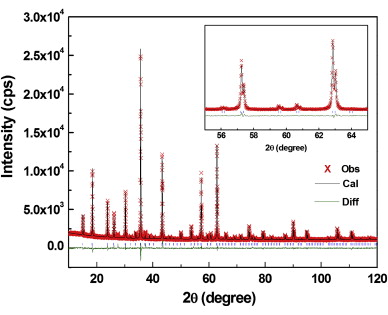 , ,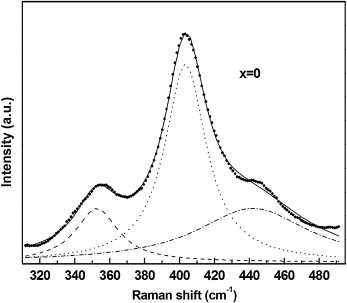
Crystal structure refinement and microwave dielectric properties of new low dielectric loss AZrNb2O8 (A: Mn, Zn, Mg and Co) ceramics (Scripta Materialia 69,(2013) 274)
S.D. Ramarao and V.R.K. Murthy
The effects of substituting different cations (Mn, Zn, Mg and Co) at the A-site of AZrNb2O8 compounds on structural parameters such as packing fraction and B-site octahedral distortion
were studied using X-ray powder diffraction in conjunction with Rietveld refinement. Variations in the dielectric constant (er) were explained by the ionic polarizability of the compositions.
The quality factor (Q × f) and temperature coefficient of resonant frequency (tf) were correlated with the packing fraction and B-site octahedral distortions (d) in these compositions, respectively.
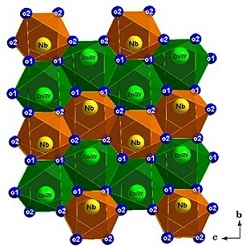 , ,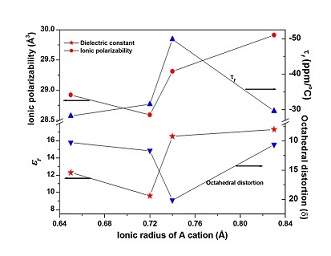
Correlation Between Structural Characteristics and Microwave Dielectric Properties of Scheelite Ca1-xCdxMoO4 Solid Solution (Journal of the American Ceramic Society 95,(2012) 3532)
S.D. Ramarao, S. Roopas Kiran and V.R.K. Murthy
Ca1-xCdxMoO4 (x = 0.0, 0.2, 0.4, 0.6, 0.8, and 1.0) ceramics were prepared by solid-state reaction method. Tetragonal scheelite structure with I41/a space group was observed in all these compositions.
Microwave dielectric properties such as quality factor (Q × f), dielectric constant (er), and temperature coefficient of resonant frequency (tf) were measured in the microwave frequency range. Rietveld
refinement was performed on all these compositions and bond valences of A-, B-site cation, and oxygen were calculated. Influence of these structural parameters on the microwave dielectric properties was examined.
Q × f was correlated with the average covalence of A-, B-site cations. The variation in er was explained with ionic polarizability of Cd+2 ions. The deviation of observed polarizability from theoretical polarizability
and tf of all these compositions were explained with oxygen bond valence. The well-sintered Ca1-xCdxMoO4 ceramics showed highly promising microwave dielectric properties (er = 8–10, Q × f = 46000–53000 GHz and tf = -22 to -57 ppm/°C).
 , ,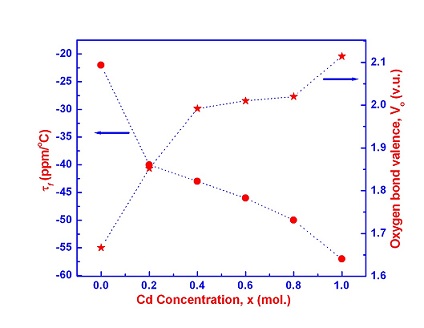
Long range B-site cation ordering and Briet–Wigner–Fano line shape of A1g-like Raman mode in Nd1-xSmx(Mg0.5Ti0.5)O3 microwave dielectric ceramics (Materials Research Bulletin 48,(2012) 194)
S. Roopas Kirana, G. Santosh Babu, Chandrabhas Narayana, V.R.K. Murthy and V. Subramanian
Nd1-xSmx(Mg0.5Ti0.5)O3 (x = 0.0–1.0) samples were prepared by solid-state reaction method. Rietveld refinement of X-ray diffraction data was done using P21/n space group with monoclinic symmetry,
which supports 1:1 B-site cation ordering. Long range ordering (LRO) parameter decreased up to x = 0.5 and then found to increase with further increase in Sm concentration. The A1g-like mode in Raman spectra
was observed to possess Briet–Wigner–Fano line shape. The variation in obtained line width of the A1g-like mode supported LRO. Microwave dielectric characteristics such as dielectric constant (?r), quality factor (Q)
and temperature coefficient of resonant frequency (tf) were measured in the range of 7–9 GHz. ?r decreased from 26.5 to 24.9 and tf become less negative from -58 ppm/°C to -36 ppm/°C with increase in Sm concentration.
Q × f decreased from 47,500 GHz (for x = 0) to 39,800 GHz (for x = 0.5) and then increased to 44,600 GHz (for x = 1).
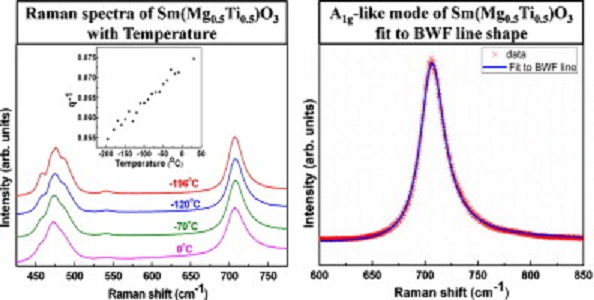
|